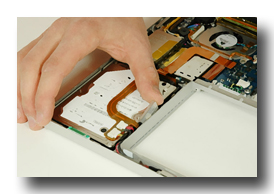 Oh, I am beginning to think it is possible to overcome one’s inner klutz. Today I performed my second successful disk drive transplant on a MacBook Pro. This latest was done to install the quite new Hitachi 7200 200GB drive (a few weeks ago I replaced another machine’s drive with the new Seagate 7200 160GB Momentus).
Oh, I am beginning to think it is possible to overcome one’s inner klutz. Today I performed my second successful disk drive transplant on a MacBook Pro. This latest was done to install the quite new Hitachi 7200 200GB drive (a few weeks ago I replaced another machine’s drive with the new Seagate 7200 160GB Momentus).
As noted in a recent BareFeats posting (and confirmed by my testing once the install was complete), this Hitachi is one fast drive. Quiet too.Turns out it’s not all that difficult to replace a drive in a MacBook pro (Core2Duo) but you need to pay attention to all the different screws (and there are quite a few). I used the screw-by-screw takeapart guide on iFixit.com and had very little trouble. The guide covers the CoreDuo version and there are very slight differences in the Core2Duo machines (it’s actually a bit easier). The one recommendation I’ll make (and it worked out well for me both times) is to tape the screws on a sheet of paper as you remove them from the computer, writing down where they came from. The tape will keep them from flying into the carpet (many are really small) and it’s a big help when the time comes to reassemble.
Grab a copy of SuperDuper or Carbon Copy Cloner to handle data transfer. Either of these utilities offers the ability to clone a drive. CCC is donationware while SuperDuper requires registration to unlock additional features beyond full clones.Those PBS videos Today we loaded 498 or so MARC records into our catalog, each describing a particular PBS video and each containing a link to a PHP script which redirects the browser to our QuickTime server for streaming. I wasn’t able to put a direct RTSP:// link in our catalog as our Voyager system doesn’t handle that protocol in the 856 field. So I built a small MySQL database with a couple of fields (one containing the OCLC number and another the corresponding URL to the proper title on our streaming server). The link in the MARC record looks like this:
http://furbo.gmu.edu/streamcatcher/bounce.php?hop=123082827
In this example, 123082827 is the OCLC number of that record. In the database, that number resolves to this link on the streaming server:
rtsp://phobos.gmu.edu:7070/PBS/800/pbs_amx002-3_800k.mp4
It all works great—if you’re using a Mac. As I found at the end of the day when I asked a colleague to test it with Windows, it doesn’t work for a Windows user. I’m not sure why but I’ll keep tweaking things until it’s working for that platform as well :)I’ll make sure I update a posting when it’s finally working right.
Update (7/9/07): Thanks to a tip from my colleague Andrew Stevens, I now have the links in our Voyager OPAC working on Windows as well—working with the QuickTime browser plugin, anyway. Changing the redirect link from rtsp:// to http:// was enough to fix the problem with Windows-based browsers. As you might well guess (and I should have recalled from my years as a Windows user), Real Player grabs (and refuses to relinquish) control over anything with an RTSP:// protocol in the URL. I’m going to have to do some more work and add some additional intelligence to my redirect code (bounce.php) to get things working for those who want to use the standalone QuickTime client. But at least now it’s working.
